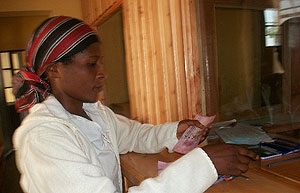If completed, Umurenge saccos will change the face of village banking in Rwanda With a paid up capital of Rwf 1.5 billion out of a capital pledge of over Rwf 3.55 billion with almost 1 million active account holders, Rwanda’s radical grassroots savings mobilization scheme commonly known as “Umurenge Saccos” is set for full licensing by Central Bank within the next 6 months.


If completed, Umurenge saccos will change the face of village banking in Rwanda
With a paid up capital of Rwf 1.5 billion out of a capital pledge of over Rwf 3.55 billion with almost 1 million active account holders, Rwanda’s radical grassroots savings mobilization scheme commonly known as "Umurenge Saccos” is set for full licensing by Central Bank within the next 6 months.
While releasing the latest version of Rwanda’s fiscal policy report known as the monetary policy and financial stability statement, the Central Bank says that during the remainder of the year 2010 it will give more attention to the completion of the licensing process of all the 416 Umurenge sacco units spread all over Rwanda.
If this happens then Rwanda will have managed to bring into a formal banking system almost 55 percent of its population of 10 million mostly rural poor folks who will be account holders of the saccos.
As one of the mechanisms that was designed to bring more unbanked Rwandans into a formal banking system government through the Central bank decided to offer provisional licenses to the Umurenge sacco units after being granted a legal status by Rwanda Cooperative Agency.
For the second phase, Central bank says that these saccos have six months starting from the date of their licensing to fulfil the remaining requirements including submission to the Central Bank of a business plan and a manual of procedures for its main activities.
"During the second half of the year Central Bank through its mission of off-site surveillance and on-site examination of micro-finance institutions will carry out the completion of licensing all the Umurenge saccos”, Governor of Central Bank Francios Kanimba said while making a presentation of the new fiscal policy as it touched on the Umurenge programme.
The Governor added that as part of monitoring the development of the new programme a study of non-repayment of loans received from other traditional micro finance institutions (MFIs) and its negative impact on the Umurenge saccos will be undertaken for the purposes of coming up with a new policy position.
The consolidation of the Umurenge sacco programme will also entail monitoring by the Central Bank of the merging process of some existing saccos with the new Umurenge units.
The Umurenge sacco system was created in line with the government strategy of domestic savings mobilization geared towards building an all inclusive financial system in Rwanda. Central Bank says that the main objective of the programme is to allow unbanked but bankable people access to financial services at low transaction costs.
Experts contend that in Africa there is a very strong market among rural dwellers for millions seeking such financial services. Traditional banking services tend to ignore such segments of the rural population due to the fact that the present banking systems do not offer them tailor made products to suit their unique needs .This is the segment of the population known as the unbanked.
However this segment of the population also constitutes an enormous opportunity –if banks are willing to embrace the challenge of including them with an eye on the bigger picture.
The establishment of Umurenge saccos was preceeded by a series of studies which paved the way for looking at ways of addressing challenges that the unbanked posed to Rwanda’s ambitious transformation agenda.
After elaborating the Economic Development and Poverty Reduction Strategy (EDPRS) with a Financial Sector Development Programme (FSDP) as one of its core components, government realised that it needed credible baseline data to profile how challenges of bringing the unbanked into a formal banking system could be addressed.
Such data would provide an insight into the obstacles that constrain access to banking by rural dwellers. The data would planners to set priorities in the development of new policies to address these obstacles.
The Central Bank contracted experts who came up with a financial segmentation model for Rwanda in 2008 which has largely influenced the establishment of the Umurenge saccos.
The study known as "Rwanda Finscope 2008” indicated that only 15 percent of Rwandans had access to a formal banking system adding that over 52 percent of Rwandans were financially excluded from access to formal banking products.


